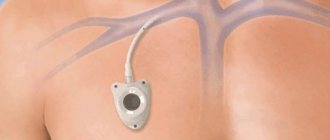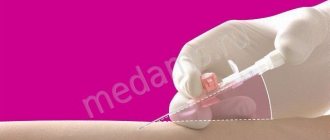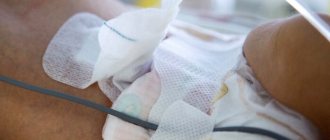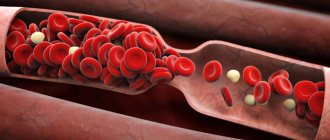Home » Articles » How to install a urinary catheter and why you can’t install it yourself
A urinary catheter is a medical procedure that helps make urination easier. It is also used in the diagnosis and treatment of diseases. It is important to know how to properly install a catheter to avoid infection in the urinary tract.
Why and how to place a catheter
This device is a small plastic or silicone tube that is inserted through the urethra into the bladder. In women and men, the length of the urethra is different; there are features of choosing and placing a catheter, with minimal discomfort for the patient. The presence of a catheter helps in draining urine generated in the kidneys, which accumulates in the bladder if a person is unable to urinate on his own. However, the Foley catheter communicates with the external environment, urine is separated through it, the product can become dirty and clogged, which requires regular cleaning and proper care. In addition, the patient needs to wash, change underwear and clothes, which requires knowledge of how to care for the Foley catheter at home .
Washing, regularly replacing catheters with new products and cleaning the Foley catheter are important to prevent the penetration of pathogenic microbes into the genitourinary tract and the development of inflammation and severe complications. Infection when using a catheter is dangerous as a relapse or complication of the underlying disease, which can lead to re-hospitalization. Regular maintenance of your Foley catheter will help prolong its life, so it will not need to be replaced as often.
Contraindications to epicystostomy
There are relatively few contraindications to suprapubic catheterization:
- small bladder capacity (microcystis) - risk of unintentional damage to the intestines or blood vessels,
- malignant tumors of the bladder,
- active infection of the skin, urinary system,
- severe coagulopathies,
- osteomyelitis of the pubic bone.
Make an appointment
Make an appointment with a urologist by calling 8(812)952-99-95 or filling out the online form - the administrator will contact you to confirm your appointment
guarantees complete confidentiality
Catheter placement
Before starting manipulations, it is necessary to perform all hygiene procedures. The doctor washes his hands thoroughly, puts on sterile gloves, and the patient’s perineum is treated with soap and water and antiseptics. The catheter is taken with sterile tweezers, the tip is treated with a lubricant to facilitate insertion.
The woman is given a special female catheter, taking into account the length and width of the urethra. It is inserted in a lying position, with knees bent and legs apart. After treating the perineum, the doctor spreads the labia, carefully inserting the tip of the catheter into the opening of the urethra. When urine begins to flow through the catheter, the administration is stopped. After this, sterile water is injected through one of the holes at the other end of the product to inflate the balloon and fix the product in the bladder. A urinal is attached to the other hole.
In men, a longer catheter is used, taking into account the size of the urethra. It is administered in the same way, in a lying position, with knees bent and legs apart. The product is moved slowly, gently, first holding the penis in a vertical position, then tilting it down. When urine separates, movement stops.
Self-catheterization
A permanent catheter is associated with a high risk of infection, which increases within 48 hours after installation, even if the doctor followed all aseptic and antiseptic measures. Therefore, after a short period of continuous catheterization, patients are advised to switch to periodic self-catheterization - if this is not possible, a stoma is installed. Self-catheterization with lubricated catheters has lower risks than stoma placement: it reduces the number of episodes of infection requiring treatment. If both long-term methods of urinary diversion are not available, the patient may be left with an indwelling catheter. In this case, it is recommended to periodically clamp the tube under the supervision of a doctor - this is how the storage function of the bladder is trained.
How to flush a Foley catheter at home
You can use a weak solution of potassium permanganate (1:10000), “Dioxidin”, which is diluted with water 1:40 or “Furacillin” (1 tablet 0.1 g per 100 ml of liquid). It is possible to rinse the catheter with Miramistin, a ready-made pharmaceutical solution, or a product recommended by the doctor. The rinsing is carried out in such a way that the patient does not experience pain or discomfort.
It is important to wash your hands thoroughly and use a sterile syringe with which the solution is delivered. The urinal is disconnected from the tube, and the end is treated with antibacterial solutions. Then attach a syringe, which slowly delivers the rinsing solution. You need to first apply about 20-30 ml, after introducing the liquid into the bladder, the syringe is disconnected. It flows back on its own. The rinsing is repeated three times, then the urinal is reattached.
Rules for proper care of an indwelling catheter
To avoid complications and infections, you need to follow certain rules for caring for a permanent urinary catheter:
- the drainage fluid is drained and the device is carefully removed;
- Urine is drained from the bag, rinsed with water, treated with an antiseptic (Chlorhexidine, boric acid solution or Dioxidine);
- the catheter itself is washed using a syringe with a volume of 50, 100 ml, first filled with an antiseptic, then under running water;
- in the presence of inflammation, the catheter is treated with Furacilin solution.
How to rinse a urinary catheter correctly and how often? The urinal itself is emptied up to 5-6 times during the day, washed with antiseptics at least once a day. The catheter should be cleaned no more than once or twice a week.
Performing a catheter replacement procedure at home is a dangerous procedure that can lead to severe injury to the urethra. It is better to trust certified specialists with experience who comply with all aseptic measures and take into account individual factors and possible contraindications.
Showering with a catheter and urine bag
It is important to maintain good body hygiene by showering regularly. This reduces the risk of infection. Before standing under the stream of water, the urinal is disconnected and the catheter is clamped with a special clip. When washing, you should gently wash the genitals around the catheter using baby or liquid soap with a neutral pH.
After bathing, the catheter tube is carefully dried, the genitals are blotted with a soft cotton towel, and a clean urine bag is put on. You can swim every day, following these rules.
Instruments and medical personnel
All types of cystostomy are performed under visual control using an ultrasound machine. As a rule, standard Foley catheters are used for open epicystotomy, and a disposable set for trocar epicystostomy is used for puncture epicystostomy.
Suprapubic catheterization is performed by a urologist, a surgeon who specializes in the genitourinary system. Other practitioners who may perform this procedure include general surgeons, gynecologists, urogynecologists, and emergency physicians and trauma surgeons.
Why do we need a port system?
Every year, many people are implanted with Celsite® port systems. Some for a few months, some for several years; it all depends on the duration of treatment. The doctor prescribes the implantation of a port system to avoid repeated intravenous interventions, which happen every time new courses of chemotherapy are prescribed. With repeated catheterizations, significant injury to the veins occurs; Frequent infusions into peripheral veins and changing catheters can lead to the development of phlebitis.
The use of port systems in patients with cancer is an integral part of the “gold standard” of treatment.
Ports are widely used in Western European countries in patients with newly diagnosed cancer who are scheduled to undergo multiple chemotherapy sessions, especially with cytostatic drugs that cause damage to peripheral veins. In addition, infusion ports are placed in patients with thin peripheral veins in the arms and legs. In domestic oncology practice, ports are rarely used.
According to the recommendations of the European Oncology Association, the most rational option is to install a port system at the earliest stage of chemotherapy, before the appearance of peripheral phlebitis, in those cancer patients who are planning to undergo long-term chemotherapy.
In Western European countries, infusion ports are installed in 95% of all patients receiving long courses of chemotherapy.
The infusion port allows you to simplify the procedures for collecting venous blood for laboratory tests, significantly facilitate parenteral nutrition, increase the efficiency of transfusion of blood components, especially platelet concentrate, as well as a number of other manipulations that require the installation of a central intravenous catheter.
How is the port installed?
The procedure for implanting an infusion port is carried out in an X-ray operating room under short-term anesthesia. In our country, unfortunately, an extremely small number of specialists have significant experience in installing port systems. Our x-ray surgeons have experience installing port systems under both x-ray and ultrasound guidance.
Find out the exact cost of treatment
During the implantation procedure, the patient does not feel any pain or discomfort. 2-3 hours after the operation and checking the functionality of the port, the patient can go home or move on to the next stage of treatment - chemotherapy.
After treating the skin with a special disinfectant solution, an injection is made with a needle into the central vein, then a thin metal conductor is inserted into the needle, through which a special catheter of approximately 2 mm in diameter is inserted. A small skin incision is made and a port is placed under the skin, then the port is connected to the catheter installed in the vein. The incision is closed with several cosmetic stitches.
What is a central venous catheter?
A central venous catheter (CVC) is installed on main, large veins and is used to connect to an infusion system or syringe.
Unlike peripheral catheters, which are installed on the saphenous veins, the manipulation of catheter installation is carried out in the projection of deep-lying large veins, such as the subclavian (under the collarbone), internal jugular (on the side of the neck), and femoral (in the groin).
Central venous catheters are widely used as long-term catheters for drug administration, blood collection, and parenteral nutrition. A subclavian venous catheter is installed for a period of no more than 3 weeks.
Installation of a venous catheter
The main indication for installing a central venous catheter is emergency conditions during resuscitation and intensive care, inaccessibility of peripheral veins, for the administration of intravenous nutrition, and during long-term intensive infusion therapy.
- Installation of a catheter for severe patients during long-term treatment in hospital and intensive care;
- Installation for administration of parenteral nutrition;
- If long-term administration of substances is necessary, for example, during chemotherapy in cancer patients;
- During planned and emergency operations, during transfusion of large volumes of solutions;
- A catheter is installed if the peripheral veins in the arms cannot be catheterized;
- For hemodialysis and hemofiltration;
- And others.
Contraindications
There are several contraindications for central venous catheterization.
- Inflammatory processes at the injection site;
- Blood clotting disorder;
- Thrombosis of the vein in which the catheter is planned to be installed;
- Clavicle injuries and bilateral pneumothorax (for subclavian access).
Complications
During and after installation of a CVC venous catheter, the following complications are possible:
- Pneumothorax and hemothorax - accumulation of air or blood in the pleural cavity;
- Hydrothorax is an accumulation of fluid in the pleural cavity;
- Catheter infection;
- Incorrect direction of the CVC, nerve damage;
- Puncture of arteries, lymphatic vessels;
- Irregular heart rhythm when advancing the catheter;
- Vein thrombosis and pulmonary embolism;
- Displacement of the subclavian catheter into the internal jugular vein.
Types of catheters
The choice of the optimal option for venous access is influenced by the duration of therapy, its frequency and regularity, requirements for system care, comfort for the patient and convenience for medical personnel, the volume of administered drugs, their physical properties, as well as the possibility of conducting infusion therapy in a hospital or on home.
Subclavian catheter. Inserting a catheter into the subclavian vein
Installation of a subclavian catheter is carried out only in a hospital setting, in the central vein, and is used in intensive care and intensive care settings if the catheter is expected to remain in the venous bed for more than 5 days. The maximum service life of the catheter with proper use is up to 3 weeks.
If there are no other contraindications, the catheter is installed in the subclavian vein. The choice of vein is based on the physiological characteristics and condition of the patient.
Implantable subcutaneous PORT systems
The port system, an implantable subcutaneous catheter, is inserted into a central vein and can be used for up to 5 years. The catheter can be 1 or 2 chambered, which allows you to administer 1-2 drugs simultaneously (alternately), mainly for chemotherapy or small volumes of drugs.
Main advantages of the port system
- The port system allows you to establish rapid venous access for the infusion of small volumes of drugs by slow infusion or blood sampling.
- The system provides painless repeated access for up to 5 years in cases of proper use and the absence of inflammatory phenomena.
- The port system does not create discomfort, is invisible, and allows you to lead a normal lifestyle.
- Infusion therapy through the port system requires placement of a Huber needle by a specialist, which requires replacement every 5-7 days.
- If the Huber needle is incorrectly inserted into the port of the system, the bottom of the port of the system may be injured, which can damage it.
The catheter port is a titanium reservoir, about 4 cm in diameter, 1 cm thick. A silicone membrane is installed on the top of the port, through which medications are infused with a special Huber needle. The port is placed under the skin, usually in the upper third of the chest.
The port system requires preventative flushing every 4-6 weeks through a Huber needle.
The oncology clinic uses more modern and easy-to-maintain analogs of port systems, such as Picc Line catheters with which the patient can be discharged home and undergo infusion therapy at home, as well as for relatives, caring for this type of catheter like Picc Line is very simple and does not require special knowledge.
Guardian Angel uses catheterization systems from the world's leading manufacturers; models differ in type, size, catheter length, and materials of manufacture.
To get a consultation
The installation price of the Picc Line single-lumen system is 35,000 rubles
The installation price of the Picc Line double-lumen system is 45,000 rubles
Implantable PICC systems (PICC)
The PIC venous catheter is an implantable catheter that is installed in a peripheral vein, which reduces possible complications to a minimum, in particular, eliminating the risk of thrombosis.
Can be used up to 6 months. The catheter can be 1, 2, 3 chamber. A PIC catheter, a silicone or polyurethane tube 45-65 cm long, may contain 1-3 isolated lumens. The distal end of the catheter may be open or have an anti-reflux valve.
Polyurethane catheters are advantageous when used in patients who require the administration of highly viscous solutions or large volumes of fluid.
Silicone catheters have higher biocompatibility and durability, are softer than polyurethane catheters, and better follow the contours of the vascular bed.
PIC catheters allow you to connect several cameras to the system, which is important for patients receiving several different drugs that are incompatible with each other at the same time.
PIC systems are installed by puncture through the medial saphenous vein of the arm. The installation procedure takes 10-30 minutes, it is simpler and safer compared to other types of devices.
It is advisable to implant PICC in patients
- Patients with tracheostomies, since they have a significantly increased risk of infection of the CVC in the area of the upper shoulder girdle;
- PICC implantation in patients with anatomical abnormalities of the neck and chest
Implantation of a PIC catheter through a peripheral vein eliminates the possibility of developing pneumothorax and hemothorax, injury to the jugular or subclavian artery.
The main advantages of the Picc Line catheter system
- The lifespan of the Picc Line catheter is 6 months.
- The Picc Line system allows you to establish rapid venous access for infusion of large volumes of drugs, blood sampling, and chemotherapy.
- Easy care of the Picc catheter for relatives, rinsing with saline once a week when the catheter is not in use, and during infusion therapy, rinsing after each infusion.
- The Picc Line catheter is installed in a peripheral vein, which reduces possible complications to a minimum, in particular, eliminating the risk of thrombosis. It also does not create discomfort and allows you to lead a normal lifestyle.
- Installation of the catheter is done quickly and painlessly.
- Picc Line catheter is a modern and easy-to-care analogue
- The catheter can be 1, 2, 3-chamber, which allows infusion of large volumes of various even incompatible drugs (for example, drugs for chemotherapy).
- The cost of a Picc Line catheter is several times lower than installing a Port system.
Oncology diagnostics
Emergency help
Innovations in symptomatic and palliative treatment of oncology at the Guardian Angel Clinic
CANCER. Stages, treatment, methods.
Features of care
To avoid complications, it is important to wash the catheter installation site twice a day with a soapy solution. In addition, certain rules must be followed:
- It is not allowed to fill the urine bag to the top edge.
- If the patient walks, the bag is fixed below the position of the bladder, for example on the thigh or lower leg.
- The bag should be emptied when it is more than 50% full.
If you experience any discomfort, it is important to notify your doctor. It is prohibited to remove the catheter yourself.
Possible complications
When monitoring a catheterized patient, they carefully monitor adverse events:
- The catheter falls out or is pulled out by the patient himself.
- Increased body temperature over 370C.
- A sharp change in color, smell, transparency, volume of urine discharge.
- Stopping urine output.
- Pain in the abdomen, back below the waist.
If you observe one of these signs, you should call a doctor. If all is well, then the doctor is scheduled to be contacted after 3 months of continuous wearing of the catheter to replace it.
When caring for a person with a urine drainage device, do not forget about the sensitivity of the problem. Such people are in dire need of tactful, restrained, skillful and respectful treatment.
How to attach a night urine bag?
When using a night urine bag simultaneously with a foot bag, do not disconnect the foot bag from the catheter.
Place the urine bag below the level of the bladder.
- Select a night bag.
- Attach the ribbed connector of the night bag to the silicone tube in the area of the drain valve of the foot bag.
- Open the drain valve, ensuring the flow of urine from the foot bag into the night bag.
- Loosen the fastening straps so that the maximum comfort is achieved while minimizing the risk of components coming apart.
- Fix the night urine bag with a hook, ensuring the optimal position of the product and the unimpeded outflow of urine.
What is included in the service?
- Installation of an infusion port system, with the cost of the port. Port.
- Initial examination by a specialist during hospitalization.
- Determination of blood group and Rh affiliation.
- Installation of a catheter in a peripheral vein.
- Blood collection.
- ECG in 12 leads (cardiodom).
- Complete blood count (CITO).
- General biochemical panel (ALB, ALP, ALT, AMY, AST, BUN, Ca, CRE, GGT, GLU, TBIL, TP, UA) (CITO).
- Stay in a day hospital - 1 hour (up to 3 hours).
- Consultation with an endovascular surgeon, candidate of medical sciences, primary.
What kind of equipment is there?
Doctors use a Foley urinary catheter in men, women, and children. This is a flexible tube made of silicone or latex with 2 or 3 channels, with an inflatable holding balloon. Silicone is preferable for the bladder. The silicone device does not cause rejection and bacteria multiply less on it. Caring for a patient with a urinary catheter is made easier by modern models with an anti-return valve. It prevents fluid from flowing back. Sterile devices are produced in individual packaging by enterprises in Germany and China.











